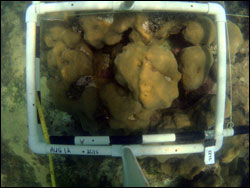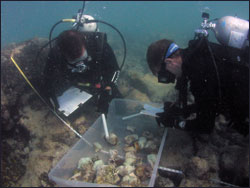Press Releases
FOR IMMEDIATE
RELEASE
Nov. 8, 2011
Contact:
Karrie Carnes
305-809-4700 ext. 236
NOAA: Coral reef successfully restored after 2002 boat grounding in Florida Keys
Corals damaged in 2002 when a boat ran aground in the Florida Keys National Marine Sanctuary are now thriving following a restoration and near decade-long monitoring effort, according to a new NOAA report released today. With hundreds of groundings happening each year in the sanctuary, lessons learned from this coral reef restoration and monitoring will guide future restoration efforts.
 In August 2002, the 36-foot long boat Lagniappe II ran aground on a shallow coral reef near Key West, Fla. damaging approximately 376 square-feet of living coral in the sanctuary. After sanctuary staff assessed the damage to the reef, restoration biologists used special cement that hardens under water to reattach 473 corals and coral fragments that had been toppled or dislodged during the grounding. The majority of affected corals were boulder star coral, a primary reef building coral in the Florida Keys. In August 2002, the 36-foot long boat Lagniappe II ran aground on a shallow coral reef near Key West, Fla. damaging approximately 376 square-feet of living coral in the sanctuary. After sanctuary staff assessed the damage to the reef, restoration biologists used special cement that hardens under water to reattach 473 corals and coral fragments that had been toppled or dislodged during the grounding. The majority of affected corals were boulder star coral, a primary reef building coral in the Florida Keys.
To determine the progress of their restoration efforts, the sanctuary and the National Coral Reef Institute of Nova Southeastern University's Oceanographic Center, used digital photographs and highly specialized computer software to count the types and amounts of coral in the damaged area as well as an adjacent unaffected reference site. Sanctuary biologists could then compare the restoration area with the reference area and note changes over time.
The sanctuary tracked coral condition at the restoration site over an eight-year period, beginning in 2002. By 2009, the reattached coral fragments were undistinguishable from the adjacent uninjured coral colonies. A year later, the amount of coral at the restoration site was higher than at the reference site.
 "The monitoring allowed us to document changes to the restored coral and measure the success of this restoration," said Hatsue Bailey, Florida Keys National Marine Sanctuary restoration biologist. "With continued use of these methods, as well as additional monitoring, we learn more about habitat changes at this location and improve upon existing restoration strategies." "The monitoring allowed us to document changes to the restored coral and measure the success of this restoration," said Hatsue Bailey, Florida Keys National Marine Sanctuary restoration biologist. "With continued use of these methods, as well as additional monitoring, we learn more about habitat changes at this location and improve upon existing restoration strategies."
Hundreds of vessel groundings are reported annually in the Florida Keys. A boat hitting the reef can topple coral heads or grind coral colonies into tiny fragments, damaging and killing coral which may have taken centuries to build. Most vessel groundings are preventable through preparation, patience, and experience.
The owner of Lagniappe II paid $56,671.27 in a negotiated settlement. Those funds were used to pay for response, damage assessment, monitoring and some restoration costs.
The coral restoration study, "Lagniappe II Coral Reef Restoration Monitoring Report, Monitoring Events 2002 to 2010, Florida Keys National Marine Sanctuary, Monroe County, Florida," and other Office of National Marine Sanctuaries' Conservation Series reports are available online at http://sanctuaries.noaa.gov/science/conservation.
Florida Keys National Marine Sanctuary protects 2,900 square nautical miles of critical marine habitat, including coral reef, hard bottom, sea grass meadow, mangrove communities and sand flats. NOAA and the State of Florida manage the sanctuary.
NOAA's mission is to understand and predict changes in the Earth's environment, from the depths of the ocean to the surface of the sun, and to conserve and manage our coastal and marine resources. Join us on Facebook , Twitter , Twitter and our other social media channels. and our other social media channels.
On the Web:
NOAA Florida Keys National Marine Sanctuary
|





